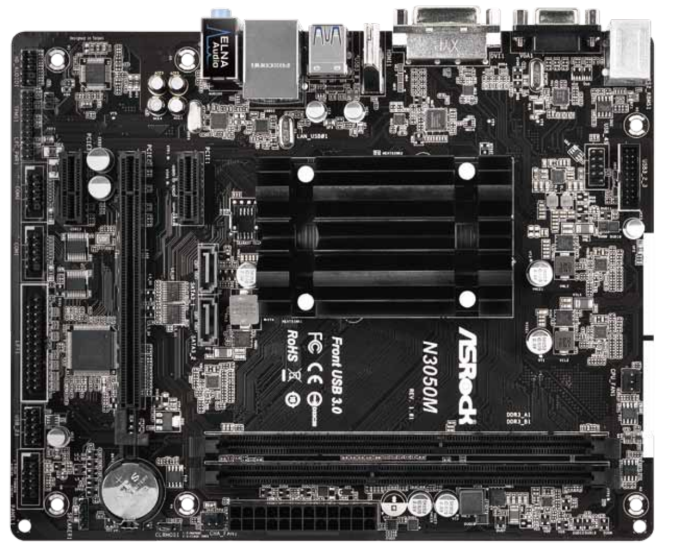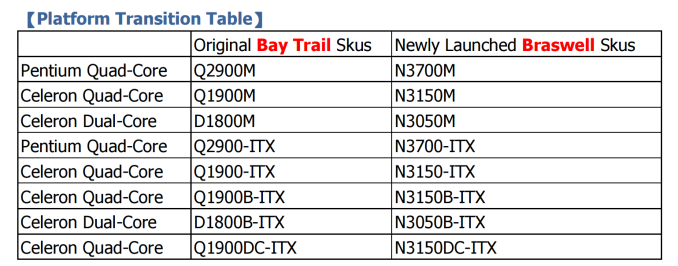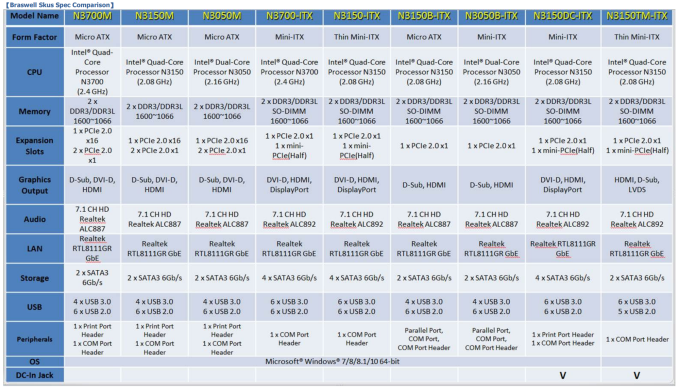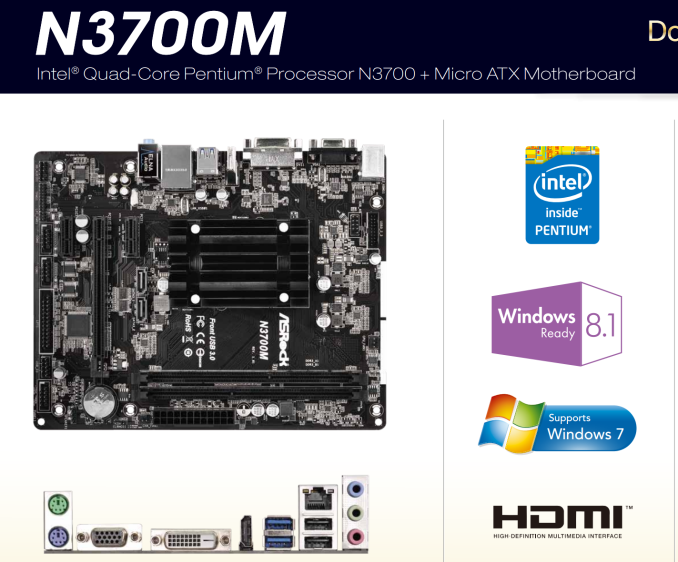ASRock Goes Braswell: Eight SKUs including DC-In Variants
by Ian Cutress on May 19, 2015 9:56 PM EST- Posted in
- Motherboards
- ASRock
- Airmont
- Braswell

In the wake of the news regarding ASUS’ listing of their Braswell motherboards, both ASRock and MSI have been quick on their heels to also list their model lines. ASRock contacted us directly, stating that they will have eight boards on offer in total, although markets for each will vary. They will also transition directly from the Bay Trail-D line, allowing for a quick drop in where required:
Where Bay Trail’s three SoCs, the D1800, Q1900 and Q2900, come into play will be a direct lift into Braswell with the N3050 taking the D1800, the N3150 taking the Q1900 and the N3700 for the Q2900. Personally I preferred the D/Q naming.
For a direct SKU-to-SKU comparison, the N3xx0M boards are microATX, featuring full length DDR3 and a full sized PCIe 2.0 x16 slot (although it will be limited in bandwidth to x1 due to the SoC). The audio codecs between the boards are split with the ALC887 on some and the ALC892 on others, although it is Realtek RTL8111GR across the board for network connectivity. Similarly all boards have SATA 6 Gbps, but some will have two and others will have four. The two SKUs at the end (N3150DC-ITX and N3150TM-ITX) are also capable of being powered by a 19V DC-In on the rear panel, with the final one also supporting LVDS.
What is interesting about the Braswell system list here is the issue surrounding soldered down processors. Rather than have one micro-ATX motherboard and put in the processor you need, we get three different motherboards (N3700M, N3150M and N3050M) that look identical down to the traces on the board but can perform differently. It means that should any of the big CPU players decide to have a non-socketed architecture (remember rumors surrounding Broadwell?) then we would end up with a lot more motherboards on the shelf that look exactly the same, except the processor under the hood.
We’ve asked for a set of the micro-ATX sized boards (and a Q2900) to see how Braswell performs compared to our previous Bay Trail testing. Also, because I feel like sticking in a $70 to $570 discrete graphics cards into one of these and see just how far CPU scaling can go.
Launches of these motherboards will be region dependent, although I have heard from other companies that Braswell isn’t necessary going to be a big launch, and potentially small volume due to the mini-PC space which is consuming more of the point-of-sale types of systems that desktop Atom used to have.
Source: ASRock













19 Comments
View All Comments
dealcorn - Wednesday, May 20, 2015 - link
"Also, because I feel like sticking in a $70 to $570 discrete graphics cards into one of these and see just how far CPU scaling can go."Several forum posts suggest folks want to know the limits of gaming on Braswell integrated graphics. What games can or can not be played at acceptable frame rates is of real concern to real consumers. I speculate less than 2% of Baytrail -D and -M motherboards have discrete graphics cards and the percent will drop lower with Braswell. Baytrail -D and -M devastated AMD's low end APU's because so few care about penultimate graphics is a predominately low end media consumption device. What is your motive in chasing the less than 2% use case? Is Braswell low end gaming now competitive with comparably priced AMD offerings? That is a real question that is of interest to a niche in the market. Discrete graphics on a low end integrated graphics motherboard is just sour grapes. It is a misuse of your talents to waste time verifying what is already known. Almost no knowledgeable person will purchase these boards to add discrete graphics because it is a dumb idea.
nathanddrews - Wednesday, May 20, 2015 - link
Is it dumb? We don't know that for sure yet because it hasn't been tested. I'm actually very curious to see what Braswell + dGPU can do for a couple reasons. One is that like Bay Trail, Braswell+mobo will be very, very cheap ($35-50). Two is that with Windows 10/DX12, CPU bottlenecks will be less impactful than under DX11. I think you could possibly build a viable gaming machine for under $200 (sans OS).dealcorn - Wednesday, May 20, 2015 - link
I foresee possible difficulty hitting a $200 price point using a $570 discrete graphics card as originally proposed. Let me understand the reasonable question you ask. Today, the cheapest Baytrail motherboard offered on Newegg is a $50 J1800 motherboard. Braswell vs Baytrail shows significant progress in efficiency and graphics, but the CPU appears to be little more than a push. Given competitive conditions I see little reason Intel would make Braswell available cheaper than Baytrail so lets assume a cheap Braswell dual core motherboard is $50 and we add in a $50 graphics card. The question would be does this $100 combination out game a $100 embedded AMD APU board? That real question goes to the heart of a seriously narrow niche. AMD APU's targeted this niche and had whatever strengths or weaknesses they had and AMD basically lost the low end market. Braswell narrows the graphics gap but with discrete graphics you trash that benefit.. AMD should outgame Braswell as much as it outgamed Baytrail. Unfortunately for AMD, there is no broad public demand for the best quality $200 desktop gaming platform. That is why they already lost the low end market. Again, reading forum posts, I think most who prioritize gaming appreciate the incremental improvements from a higher budget are big and they are willing to pay more for a clearly superior experience. I expect millions of hours will be spent gaming affordably on Braswell, but it will not be a high end experience, just fun.To recap, high end desktop gaming leadership delivers market share. Low end desktop gaming leadership is noise. On an oblique note, low end Android tablet gaming leadership that does not burn your hands may also deliver market share. Maybe the market is not nice, but it is what it is.
Kakti - Wednesday, May 20, 2015 - link
At least for me, I'm interested in the result simply to see how these chips perform when not GPU bound. By putting in a top of the line discrete card, we can see just how far the Braswell chips can be pushed.It's certainly not a likely build for anyone, but I think the results will be interesting nonetheless. If you don't want to read that future review, no one is forcing you to....
nathanddrews - Wednesday, May 20, 2015 - link
LOL well no, obviously a $200 build with a $500 GPU would be impossible. $50 is too high - these mITX Atom combos sell for $30 pretty regularly, but sure let's use $50. Spend between $50-80 on a GPU on sale/rebate (250, 250X, 750), $40 for 8GB RAM, $30 POS case with PSU, $40 for a 500GB HDD or 64GB SSD. Not bad for $210-240. It'll run circles around a comparably-priced AMD system in CPU and GPU benchmarks (Newegg only carries the dual-core E2100 for $50). Would I buy one? Probably not. :DSunLord - Thursday, May 21, 2015 - link
Why bother putting a x16 slot on the board when a open ended 1x slot would of been far better and it would look less like decepetive marketing...DanNeely - Friday, May 22, 2015 - link
an x16 slot does a much better job of physically securing a longer card.yannigr2 - Friday, May 22, 2015 - link
8 motherboards? There are 9 in the table with the specs.grooves21 - Sunday, May 24, 2015 - link
Intel's branding is a mess... It's impossible for a layperson to understand the difference between Pentium, Celeron, Atom, etc. Especially when the names crossover the same architecture.